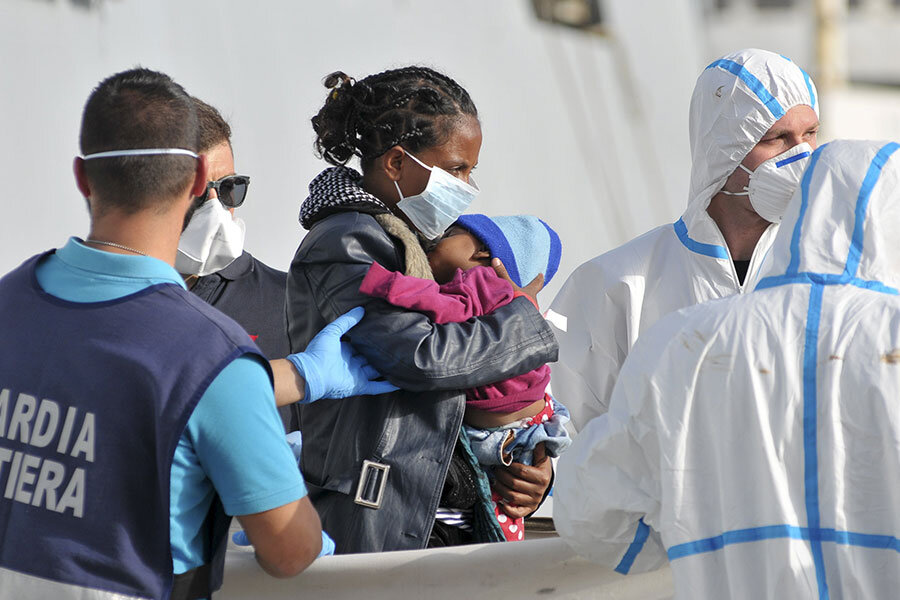Moments from safety, migrants die trying to reach Europe
Loading...
| CATANIA, Sicily
Young men piled over each other, some shimmying up ropes dangling from the towering rescue ship and others falling into the churning sea. Women and children were the last off the stricken dinghy during a chaotic Mediterranean rescue in which at least five migrants were crushed to death and more were feared drowned.
Dramatic footage shot by a seaman aboard the Maltese freighter showed the weekend rescue of more than 100 West Africans aboard the flimsy boat off the coast of Libya. Survivors were brought Tuesday to the Sicilian port of Catania.
The video, obtained by The Associated Press, highlights the danger of marine rescue, where safety and tragedy too often lie just moments apart. With 10,000 trying to cross the sea on small boats launched by human traffickers from Libya – and hundreds dying in the attempt – the question of how best to save migrants from drowning has taken center stage in Europe.
Crew members interviewed by the AP said everyone aboard the cargo ship Zeran had undergone rescue training. But while a previous rescue several weeks ago happened calmly without any loss of life, on Sunday elation at the prospect of being saved quickly turned to panic.
Unaware that they would be thrown a ladder, frantic migrants trampled over one another to reach the ropes that were meant to hold it in place, with some dangling precariously as they clambered along the lines to reach the tall freighter.
Some jumped or fell overboard to catch lifesavers tossed into the water by crew members. Others emptied jerry cans of gasoline to use as floats, as the dinghy – already deflated at the front – began taking in water.
"Easy! Easy!" implored a crew member from Zeran's deck.
"There was the big ship there and they threw down ropes," Astou Fall Dia, a 24 year-old migrant from Senegal, told the AP after disembarking from the cargo ship.
"Someone grabbed onto the rope. All the other people started pushing to try to save themselves but the people started falling in the water."
Dia said she survived because she stayed close to the dinghy, and because she knew how to swim – unlike most of the migrants who come from poor African countries.
Five bodies were recovered from inside the dinghy, floating amid garbage and water that had seeped in. A crew member said they died in the final rush to be rescued and the Catania prosecutor's office said late Tuesday that a preliminary investigation showed they were crushed to death.
At least another five to nine people fell into the water and drowned, said the seaman who shot the video, though one man floating away with the current and clinging to a lifesaver was rescued by crew on a Zeran lifeboat.
The seaman and other crew members spoke on condition of anonymity because they were not authorized to speak to the media.
Save the Children, which interviewed the survivors upon their arrival, said the migrants reported "dozens" of people died in the rescue 25 miles off the Libyan coast.
The weekend saw a dramatic increase in rescues as smugglers in Libya took advantage of calm seas and warm weather to send thousands of would-be refugees out into the Mediterranean in overloaded rubber boats and fishing vessels. The coast guard reported that nearly 7,000 people were rescued in the three days ending Sunday.
On Tuesday, the Italian Mission to the United Nations tweeted that coast guard just rescued 300 migrants in the Mediterranean, 80 miles off the Italian coast.
The latest deaths come on top of the estimated 800 migrants who are believed to have drowned last month when their boat capsized off Libya with hundreds of passengers locked in the hold by smugglers. A few days earlier, some 400 people were feared drowned in another capsizing.
After those deaths, the European Union held an emergency summit and agreed to contribute more boats and patrol aircraft to Mediterranean rescue efforts.
Even with the increased EU response, commercial cargo ships are increasingly being called on by Italy's coast guard to respond to migrants in need, as required by the law of the sea.
Catania prosecutor Giovanni Salvi complained last month that the commercial crews sometimes aren't trained or equipped to conduct rescues and that lives can be lost when migrants suddenly rush to one side of their unseaworthy boats as they try to get off.
Mr. Salvi later backtracked and praised the work and commitment of the commercial vessels.
But when the coast guard rescues migrant boats, it usually sends out inflatable speedboats and crews use loudspeakers to implore the passengers in various languages to stay calm and in their place.
It was clear from the footage obtained by the AP that either there was a language barrier, or the migrants couldn't hear the crew's instructions from high up on the deck – or both – in Sunday's rescue.
A second dinghy, picked up by the Italian navy the same day, suffered no casualties. Those migrants were later transferred to the Zeran.
Alpha Sisse, a 17-year-old from Ivory Coast who was among those rescued from the second boat, said he had talked to survivors from the stricken vessel.
"At least five people drowned, more are missing," he said. "They say maybe 20 people died."
Mr. Sisse said he left Libya because of the growing danger from fighting there.
Asked where he hoped to go from here, Sisse said: "Anywhere there is work."





